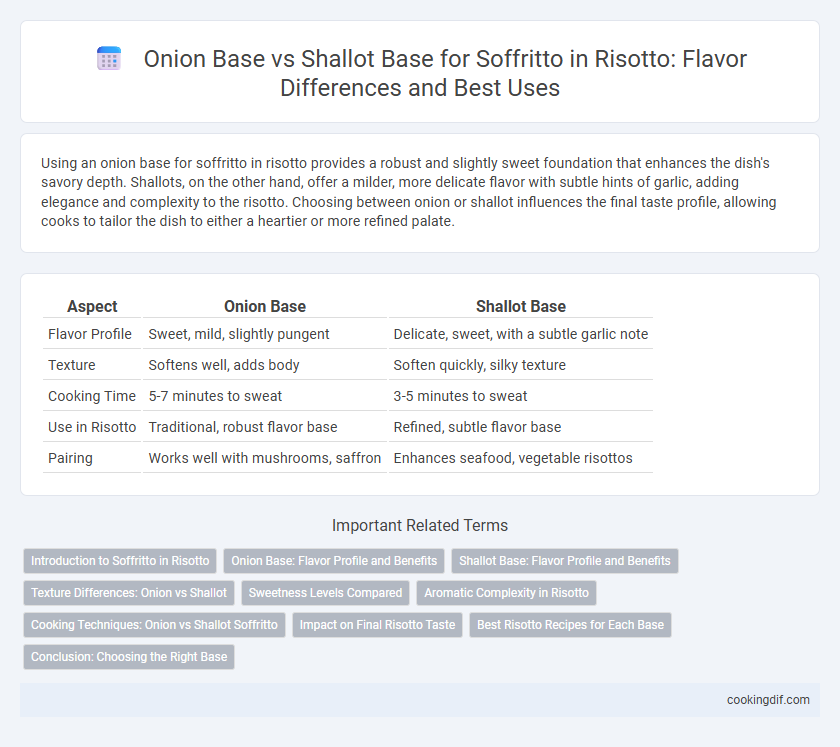Using an onion base for soffritto in risotto provides a robust and slightly sweet foundation that enhances the dish's savory depth. Shallots, on the other hand, offer a milder, more delicate flavor with subtle hints of garlic, adding elegance and complexity to the risotto. Choosing between onion or shallot influences the final taste profile, allowing cooks to tailor the dish to either a heartier or more refined palate.
Table of Comparison
| Aspect | Onion Base | Shallot Base |
|---|---|---|
| Flavor Profile | Sweet, mild, slightly pungent | Delicate, sweet, with a subtle garlic note |
| Texture | Softens well, adds body | Soften quickly, silky texture |
| Cooking Time | 5-7 minutes to sweat | 3-5 minutes to sweat |
| Use in Risotto | Traditional, robust flavor base | Refined, subtle flavor base |
| Pairing | Works well with mushrooms, saffron | Enhances seafood, vegetable risottos |
Introduction to Soffritto in Risotto
Soffritto in risotto typically starts with finely chopped onions or shallots sauteed in butter or oil to build a flavorful base. Onions offer a sweeter, more neutral profile that deepens as it caramelizes, supporting the rice's creamy texture without overpowering the dish. Shallots provide a milder, slightly garlic-like aroma, adding complexity and subtle sweetness ideal for delicate risotto variations.
Onion Base: Flavor Profile and Benefits
An onion base in soffritto provides a sweet and robust flavor that enhances the depth of risotto, creating a rich and savory foundation. Onions, particularly yellow or white varieties, offer a balanced aroma that intensifies as they caramelize, adding complexity without overpowering other ingredients. Their natural sugars promote a well-rounded, hearty taste essential for classic risotto recipes.
Shallot Base: Flavor Profile and Benefits
A shallot base for soffritto in risotto offers a delicate, sweet, and slightly garlicky flavor that enhances the dish's complexity without overpowering the other ingredients. Shallots provide a smoother texture and a subtler aromatic profile compared to onions, allowing the rice and broth to shine while adding nuanced depth to the overall taste. This subtlety in flavor makes shallots an excellent choice for light, refined risotto varieties like seafood or vegetable risottos.
Texture Differences: Onion vs Shallot
Onions in soffritto create a robust texture with a slightly crunchy bite that softens but retains some body during risotto cooking. Shallots produce a smoother, silkier base, offering a delicate mouthfeel that blends seamlessly into the creamy risotto consistency. Choosing onions enhances hearty texture contrasts, while shallots ensure a subtle, cohesive softness in the final dish.
Sweetness Levels Compared
Shallots provide a milder, sweeter flavor compared to onions in a soffritto base, enhancing the risotto's overall delicacy and subtle sweetness. Onions deliver a more robust, savory taste with a slight sharpness, contributing depth and complexity to the dish. Choosing shallots over onions can result in a softer, more nuanced sweetness that complements the creamy texture of traditional Italian risotto.
Aromatic Complexity in Risotto
Using an onion base for soffritto in risotto delivers a sweet and mellow foundation that enhances the dish's comforting profile. Shallots provide a more delicate and nuanced aromatic complexity with subtle hints of garlic and mild onion, enriching the risotto with layered flavors. The choice between onion and shallot influences the depth and sophistication of the risotto's aroma, affecting the overall sensory experience.
Cooking Techniques: Onion vs Shallot Soffritto
Onion soffritto delivers a robust, sweet foundation for risotto, releasing natural sugars when sauteed to enhance depth and caramelization. Shallot soffritto offers a delicate, subtler flavor with a hint of garlic and mild sweetness, ideal for lighter, more refined risotto varieties. Mastering heat control and timing is critical to avoid bitter notes in onions or overpowering aromas in shallots during the soffritto stage.
Impact on Final Risotto Taste
Using an onion base in soffritto imparts a robust, slightly sweet flavor that deepens the overall taste of risotto, providing a classic foundation. A shallot base offers a subtler, more delicate sweetness with mild garlic undertones, enhancing the dish's complexity without overpowering other ingredients. The choice between onion and shallot soffritto significantly influences the risotto's flavor profile, with onion contributing richness and shallot delivering nuanced elegance.
Best Risotto Recipes for Each Base
Using an onion base for soffritto in risotto imparts a robust, sweet flavor that complements hearty ingredients like mushrooms and sausage, making it ideal for classic risotto alla Milanese or porcini risotto recipes. A shallot base offers a more delicate, subtle sweetness, enhancing light risottos such as seafood or asparagus risotto by preserving the freshness of the main ingredients. Selecting the appropriate soffritto base is crucial in risotto preparation to balance the dish's overall flavor profile and highlight specific recipe elements.
Conclusion: Choosing the Right Base
Choosing the right base for soffritto in risotto hinges on flavor preference and desired aroma intensity. Onions provide a robust, sweet foundation that enhances depth, while shallots offer a milder, more delicate taste with subtle sweetness and complexity. Both choices enrich risotto uniquely, but selecting between an onion or shallot base ultimately depends on whether a stronger or more refined flavor profile is preferred.
Onion base vs shallot base for soffritto Infographic

 cookingdif.com
cookingdif.com